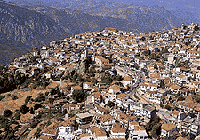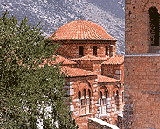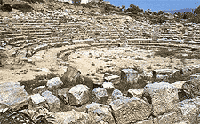Lying adjacent to Attica, this region is equally enjoyable winter and summer.
The shores of the Euboean (Evoikos) and Corinthian (Korinthiakos) gulfs, the ski center at Parnassos, the wealth of archaeological sites at Orhomenos, Chaironia, Plataiai, Thebes and elsewhere are guaranteed to hold your interest.
 The climate is dry and Mediterranean and the vegetation, with the exception of the fertile plains of Thebes and Kopaida, is rather sparse among the bare rocks.
The climate is dry and Mediterranean and the vegetation, with the exception of the fertile plains of Thebes and Kopaida, is rather sparse among the bare rocks.
In ancient times, Viotia (Boeotia) was called “tristhalatto” (three-sea’d) – a name mentioned by Strabo – because it was washed by the two halves of the gulf of Euboea and the Corinthian Gulf.
Livadia (135 km. from Athens), the capital of the prefecture, is built between two hills on the sides of a gorge through which flow the springs of Erkina. On the top of one of the hills, Profitis Ilias, there is a well-preserved 14th century medieval castle. In ancient times Livadia was known under the name of Mideia and was the site of the famous Oracle of Zeus Trofonios. Scholars have identified the location of the sanctuary, of Zeus and the Oracle as being on Profitis Ilias. Livadia is very fertile thanks to the abundant water in the region and the two springs known in mythology as Lethe (Forgetfulness) and Mnemosyne (Memory), in the north of the town at the site of Kria.
Easter here is celebrated with particular color. The whole town becomes an open-air barbecue and everywhere spitted lamb, “kokoretsi” and “splinandero” (tasty kebabs made of the innards), and local red wine are served to one and all. Musical instruments, folk dances and all-night revels complete the traditional Easter festivities at Livadia.
Chaironia (Heronia). A Vilage of great archaeological interest and Plutarch’s birthplace lies near the battlefield where in 338 BC Philip of Macedonia defeated the allied forces of the other Greek city-states. At the entrance to town stands the Lion of Chaironia, symbol of courage and bravery.
 Nearby one can see the ruins of the acropolis and theater, while the small archaeological museum contains various objects found in the vicinity. (Chaironia and Orhomenos).
Nearby one can see the ruins of the acropolis and theater, while the small archaeological museum contains various objects found in the vicinity. (Chaironia and Orhomenos).
Orhomenos, one of the oldest and richest cities of ancient Greece, is today a low-lying, well-watered town. Worth visiting here are the Byzantine church of the Dormition of the Virgin (9th c.) and a vaulted Mycenaean tomb known as the “Treasury of Minyes”. The ancient acropolis has ruins of temples, a theater and other buildings. Don’t leave Orhomenos without tasting its delicious trout, renowned throughout Greece, or its similarly famous fragrant melons.
Arahova is a mountain town little touched by modern development. At an altitude of 940 meters, its quaint houses are built up the slopes of Mt. Parnassos. This is a good place to buy handwoven fabrics, “flokates” (rugs) and colored shoulder bags, and you shouldn’t miss trying the local specialities in one of the town’s many tavernas.
Arahova lies 35 km. west of Livadia and is a usual stop for people headed for Delphi or the Parnassos ski center. Most of the skiers, novices or experienced, spend their nights in Arahova.
If you happen to visit Arahova in the spring, try to attend the huge celebration that occurs on St. George’s day on April 23rd. The entertainment lasts three days and icludes a race for old men dressed up in local costume followed by feasting on roast lamb. Just 10 km. east of Distomo, a town with important archaeological finds and an interesting museum, which played an important role in the Revolution of 1821, one comes to the Byzantine monastery of Ossios Loukas, whose 11th century mosaics and frescoes are among the finest in Greece.
 Thebes (Thiva) (87 km. from Athens), built in a fertile, low-lying region, is very interesting archaeologically. It is said to have been founded by the Phoenician King, Kadmos. Among the heroes of Thebes, which became famous mainly for its adversities, is one of the most tragic figures of mythology, Oedipus, whose story inspired the most illustrious Greek tragedians, Aeschylus (“Seven Against Thebes”), Sophocles (“Oedipus Rex”, “Antigone”) and Euripides (“Phoenician Women”).
Thebes (Thiva) (87 km. from Athens), built in a fertile, low-lying region, is very interesting archaeologically. It is said to have been founded by the Phoenician King, Kadmos. Among the heroes of Thebes, which became famous mainly for its adversities, is one of the most tragic figures of mythology, Oedipus, whose story inspired the most illustrious Greek tragedians, Aeschylus (“Seven Against Thebes”), Sophocles (“Oedipus Rex”, “Antigone”) and Euripides (“Phoenician Women”).
Thebes was also the birthplace of Hercules, known for his wondrous feats. Apart from being the homeland of myths and heroes, the city also gave birth to extraordinary men like the poet Pindar, the generals Epaminondas and Pelopidas, and others.
We recommend that you visit the superb archaeological museum, the Mycenaean tombs in the area, the ruins of the temple of Ismenios Apollo and the spring of Aghii Theodori, known in antiquity as the “Fountain of Oedipus”.
Other sights worth noting are: the Fountain of Dirki at the Frankish aqueduct, the Byzantine church of Aghia Fotini, the catacombs of the early Christian church of St. Catherine, the church of St. Luke the Evangelist in the town’s first cemetery, which contains a 13th century sarcophagus supposed to have held the saint’s body.
Using Thebes as a base one can visit Plataiai (Platees) (18 km.) and Lefktra, the sanctuary of Kabeirians, the Mycenean Acropolis Gla or Goulas on Mt. Ptoon, Tanagra, renowned for its terra cotta figurines, Vathi Avlidas, Faros and Dilessi.
Two kilometers north of Vathi lie the ruins of ancient Aulis (Avlida), where myth recounts that Agamemnon sacrificed his daughter Iphigenia to the goddess Artemis. And one must not overlook the lovely beaches in the region – Distomo Beach, Andikira, Aghios Issidoros, Vathi Avlidas, Faros, Sarandi Beach – which, whether sandy or pebbly, offer superb bathing conditions.
The shores of the Euboean (Evoikos) and Corinthian (Korinthiakos) gulfs, the ski center at Parnassos, the wealth of archaeological sites at Orhomenos, Chaironia, Plataiai, Thebes and elsewhere are guaranteed to hold your interest.
 The climate is dry and Mediterranean and the vegetation, with the exception of the fertile plains of Thebes and Kopaida, is rather sparse among the bare rocks.
The climate is dry and Mediterranean and the vegetation, with the exception of the fertile plains of Thebes and Kopaida, is rather sparse among the bare rocks. In ancient times, Viotia (Boeotia) was called “tristhalatto” (three-sea’d) – a name mentioned by Strabo – because it was washed by the two halves of the gulf of Euboea and the Corinthian Gulf.
Livadia (135 km. from Athens), the capital of the prefecture, is built between two hills on the sides of a gorge through which flow the springs of Erkina. On the top of one of the hills, Profitis Ilias, there is a well-preserved 14th century medieval castle. In ancient times Livadia was known under the name of Mideia and was the site of the famous Oracle of Zeus Trofonios. Scholars have identified the location of the sanctuary, of Zeus and the Oracle as being on Profitis Ilias. Livadia is very fertile thanks to the abundant water in the region and the two springs known in mythology as Lethe (Forgetfulness) and Mnemosyne (Memory), in the north of the town at the site of Kria.
Easter here is celebrated with particular color. The whole town becomes an open-air barbecue and everywhere spitted lamb, “kokoretsi” and “splinandero” (tasty kebabs made of the innards), and local red wine are served to one and all. Musical instruments, folk dances and all-night revels complete the traditional Easter festivities at Livadia.
Chaironia (Heronia). A Vilage of great archaeological interest and Plutarch’s birthplace lies near the battlefield where in 338 BC Philip of Macedonia defeated the allied forces of the other Greek city-states. At the entrance to town stands the Lion of Chaironia, symbol of courage and bravery.
 Nearby one can see the ruins of the acropolis and theater, while the small archaeological museum contains various objects found in the vicinity. (Chaironia and Orhomenos).
Nearby one can see the ruins of the acropolis and theater, while the small archaeological museum contains various objects found in the vicinity. (Chaironia and Orhomenos). Orhomenos, one of the oldest and richest cities of ancient Greece, is today a low-lying, well-watered town. Worth visiting here are the Byzantine church of the Dormition of the Virgin (9th c.) and a vaulted Mycenaean tomb known as the “Treasury of Minyes”. The ancient acropolis has ruins of temples, a theater and other buildings. Don’t leave Orhomenos without tasting its delicious trout, renowned throughout Greece, or its similarly famous fragrant melons.
Arahova is a mountain town little touched by modern development. At an altitude of 940 meters, its quaint houses are built up the slopes of Mt. Parnassos. This is a good place to buy handwoven fabrics, “flokates” (rugs) and colored shoulder bags, and you shouldn’t miss trying the local specialities in one of the town’s many tavernas.
Arahova lies 35 km. west of Livadia and is a usual stop for people headed for Delphi or the Parnassos ski center. Most of the skiers, novices or experienced, spend their nights in Arahova.
If you happen to visit Arahova in the spring, try to attend the huge celebration that occurs on St. George’s day on April 23rd. The entertainment lasts three days and icludes a race for old men dressed up in local costume followed by feasting on roast lamb. Just 10 km. east of Distomo, a town with important archaeological finds and an interesting museum, which played an important role in the Revolution of 1821, one comes to the Byzantine monastery of Ossios Loukas, whose 11th century mosaics and frescoes are among the finest in Greece.
 Thebes (Thiva) (87 km. from Athens), built in a fertile, low-lying region, is very interesting archaeologically. It is said to have been founded by the Phoenician King, Kadmos. Among the heroes of Thebes, which became famous mainly for its adversities, is one of the most tragic figures of mythology, Oedipus, whose story inspired the most illustrious Greek tragedians, Aeschylus (“Seven Against Thebes”), Sophocles (“Oedipus Rex”, “Antigone”) and Euripides (“Phoenician Women”).
Thebes (Thiva) (87 km. from Athens), built in a fertile, low-lying region, is very interesting archaeologically. It is said to have been founded by the Phoenician King, Kadmos. Among the heroes of Thebes, which became famous mainly for its adversities, is one of the most tragic figures of mythology, Oedipus, whose story inspired the most illustrious Greek tragedians, Aeschylus (“Seven Against Thebes”), Sophocles (“Oedipus Rex”, “Antigone”) and Euripides (“Phoenician Women”). Thebes was also the birthplace of Hercules, known for his wondrous feats. Apart from being the homeland of myths and heroes, the city also gave birth to extraordinary men like the poet Pindar, the generals Epaminondas and Pelopidas, and others.
We recommend that you visit the superb archaeological museum, the Mycenaean tombs in the area, the ruins of the temple of Ismenios Apollo and the spring of Aghii Theodori, known in antiquity as the “Fountain of Oedipus”.
Other sights worth noting are: the Fountain of Dirki at the Frankish aqueduct, the Byzantine church of Aghia Fotini, the catacombs of the early Christian church of St. Catherine, the church of St. Luke the Evangelist in the town’s first cemetery, which contains a 13th century sarcophagus supposed to have held the saint’s body.
Using Thebes as a base one can visit Plataiai (Platees) (18 km.) and Lefktra, the sanctuary of Kabeirians, the Mycenean Acropolis Gla or Goulas on Mt. Ptoon, Tanagra, renowned for its terra cotta figurines, Vathi Avlidas, Faros and Dilessi.
Two kilometers north of Vathi lie the ruins of ancient Aulis (Avlida), where myth recounts that Agamemnon sacrificed his daughter Iphigenia to the goddess Artemis. And one must not overlook the lovely beaches in the region – Distomo Beach, Andikira, Aghios Issidoros, Vathi Avlidas, Faros, Sarandi Beach – which, whether sandy or pebbly, offer superb bathing conditions.

